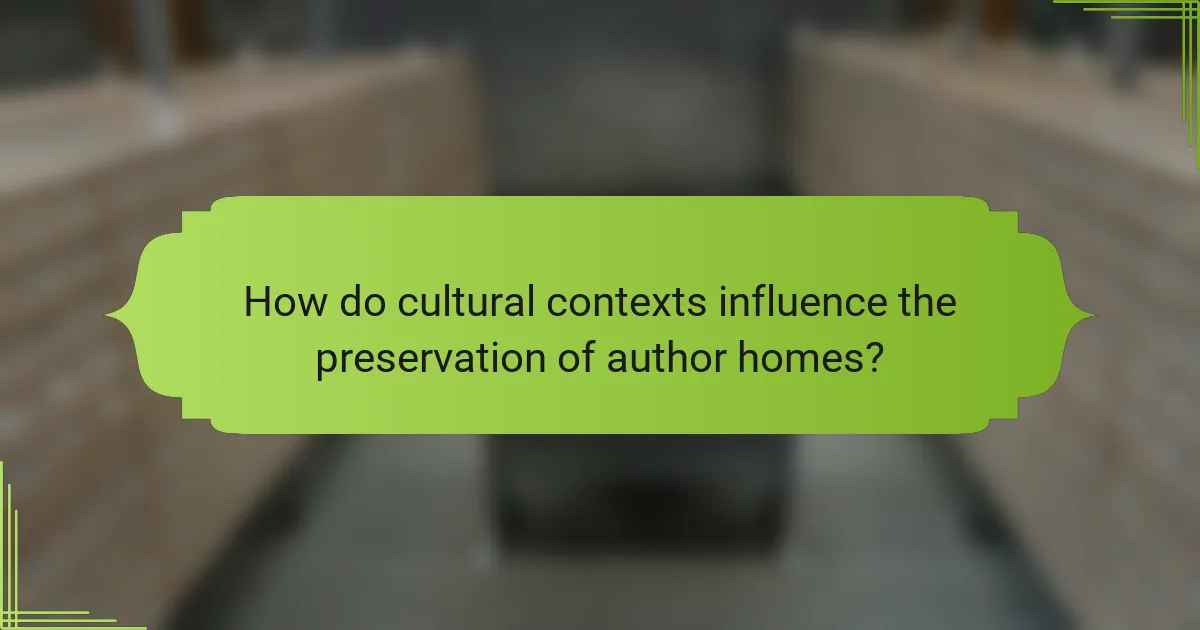Exploring iconic author homes provides a deeper understanding of their lives and literary contributions. This article highlights notable sites like The Mark Twain House and the Ernest Hemingway Home. It discusses the unique features of each location, the cultural contexts influencing their preservation, and logistical considerations for visitors. Additionally, it addresses challenges these homes face and offers tips for maximising the experience.
![]()
Which iconic author homes are must-visit destinations?
Literary journeys to iconic author homes offer unique insights into their lives and works. Must-visit destinations include:
1. The Mark Twain House, Hartford, Connecticut – A stunning Gothic Revival home where Twain wrote many classics.
2. The Ernest Hemingway Home and Museum, Key West, Florida – The residence where Hemingway penned several novels and short stories.
3. The Brontë Parsonage Museum, Haworth, England – The family home of the Brontë sisters, showcasing their literary legacy.
4. Virginia Woolf’s Monk’s House, Sussex, England – A tranquil retreat reflecting Woolf’s life and writing.
5. The Charles Dickens Museum, London, England – The only surviving residence of Dickens, filled with memorabilia and insights into his life.
6. Louisa May Alcott’s Orchard House, Concord, Massachusetts – The setting for “Little Women,” preserved to reflect Alcott’s world.
What makes each author’s home historically significant?
Each author’s home holds historical significance due to its connection to their literary contributions and personal lives. For example, the home of Ernest Hemingway in Key West showcases his writing process and influences. The Brontë Parsonage in Haworth reveals the environment that shaped the Brontë sisters’ works. Mark Twain’s house in Hartford reflects his social activism and literary achievements. These homes serve as cultural landmarks, preserving the legacy of their inhabitants and offering insight into their creative journeys.
How can visiting these homes enhance literary appreciation?
Visiting iconic author homes enhances literary appreciation by providing immersive experiences that connect readers to the authors’ lives and inspirations. These homes often showcase personal artifacts, manuscripts, and environments that influenced their works. Engaging with these spaces fosters a deeper understanding of literary contexts and themes. For example, standing in the rooms where classic novels were penned can evoke emotional responses and spark creative insights. Furthermore, guided tours often include rich narratives about the authors’ struggles and triumphs, adding layers to the reading experience.

What unique features do these author homes offer?
Iconic author homes offer unique features that enhance the literary experience. These homes often showcase original manuscripts, personal artifacts, and immersive exhibits. For example, the Ernest Hemingway Home in Key West features a lush garden and original furnishings, reflecting his lifestyle. The Brontë Parsonage Museum in Haworth provides insight into the Brontë sisters’ lives with preserved rooms and personal items. Additionally, many homes host literary events and guided tours that deepen visitors’ understanding of the authors’ works and inspirations.
How do architectural styles reflect the authors’ lives and works?
Architectural styles often mirror the authors’ experiences, influences, and philosophies. For instance, the rustic charm of a countryside cottage may reflect an author’s yearning for simplicity and nature. In contrast, urban settings can symbolise a connection to modernity and complexity in their works. Notable homes like the Victorian abode of Charles Dickens showcase intricate designs that parallel the detailed narratives in his stories. Similarly, the minimalist architecture of Virginia Woolf’s home emphasises her focus on clarity and introspection in her writing. These homes serve as tangible representations of the authors’ lives, offering insights into their creative processes and personal journeys.
What personal artifacts can visitors expect to see?
Visitors can expect to see a variety of personal artifacts, including handwritten manuscripts, first editions, and personal letters. These items provide insight into the authors’ lives and creative processes. For example, the home of Ernest Hemingway features his typewriter and personal photographs, while the Charles Dickens Museum showcases his writing desk and original manuscripts. Each artifact reflects the unique attributes of the authors, enhancing the literary journey experience.

How do cultural contexts influence the preservation of author homes?
Cultural contexts significantly influence the preservation of author homes by shaping public interest and funding. Local traditions, historical significance, and community values determine how these sites are maintained. For example, in England, the homes of authors like Jane Austen attract tourism, leading to dedicated preservation efforts. In contrast, lesser-known authors may struggle for attention and resources. The unique attributes of each home, such as architectural style and historical events associated with the author, also play a crucial role in preservation initiatives.
What role do local communities play in maintaining these sites?
Local communities play a vital role in maintaining iconic author homes by fostering preservation efforts and promoting cultural heritage. They often organise volunteer initiatives for restoration projects, ensuring these sites remain accessible and relevant. Community engagement enhances visitor experiences through guided tours that share local narratives. Additionally, local businesses benefit economically by attracting literary tourists, creating a sustainable ecosystem around these historical sites.
How do different countries approach literary tourism?
Countries approach literary tourism by promoting author homes as cultural heritage sites, enhancing visitor experiences through guided tours and literary festivals. For instance, the United Kingdom celebrates the homes of authors like Jane Austen and Charles Dickens, while the United States highlights Mark Twain’s residence. France showcases Victor Hugo’s house, emphasising literary history. Each country integrates local culture into the tourism experience, providing insights into the authors’ lives and works. This approach fosters appreciation for literature and boosts local economies through tourism.

What are the logistical considerations for visiting author homes?
Logistical considerations for visiting author homes include planning for accessibility, opening hours, and guided tours. Researching location details helps ensure a smooth visit. Consider transportation options, accommodation nearby, and any special events at the site. Some homes may have unique attributes, such as seasonal tours or specific visitor limits.
How can travellers plan an itinerary that includes multiple homes?
Travellers can plan an itinerary that includes multiple iconic author homes by mapping locations and scheduling visits based on proximity. Start by selecting authors of interest and identifying their homes worldwide, such as the homes of Jane Austen in England or Mark Twain in the United States. Prioritise visits based on geographic clustering to minimise travel time. Consider local transportation options, seasonal events, and guided tours that enhance the experience. Finally, allocate time for reflection and exploration of the literary significance of each home, enriching the journey.
What are the best times of year to visit these sites?
The best times of year to visit iconic author homes vary by location but generally align with spring and autumn. Spring offers blooming gardens and pleasant weather, while autumn features vibrant foliage. Specific sites may have unique peak seasons based on local events or anniversaries. For example, visiting the Ernest Hemingway Home in Key West is ideal from December to April, while the Mark Twain House in Hartford is best in summer for outdoor events.

What challenges do author homes face today?
Author homes face challenges such as funding, maintenance, and visitor engagement. Many require significant financial support to preserve their historical integrity. Increasing operational costs strain budgets, while attracting visitors in a digital age demands innovative marketing strategies. Additionally, the need for educational programming and community involvement remains critical for relevance.
How does funding impact the preservation of literary sites?
Funding significantly enhances the preservation of literary sites by providing necessary resources for maintenance and restoration. Financial support allows organisations to conduct repairs, improve visitor experiences, and promote educational programs. For instance, historic author homes can receive grants that ensure their structural integrity and accessibility. Increased funding also enables outreach initiatives, attracting more visitors and fostering greater appreciation for literary heritage. Ultimately, well-funded literary sites can thrive as cultural landmarks, preserving the legacy of iconic authors for future generations.
What are common misconceptions about visiting author homes?
Many believe visiting author homes is solely about nostalgia. In reality, these sites offer immersive experiences that connect visitors to literary history. A common misconception is that these homes are merely museums filled with artifacts. Instead, they often include interactive exhibits, guided tours, and events that enhance understanding of the author’s life and work.
Another myth is that author homes are only for die-hard fans. In truth, they appeal to a broader audience, including those interested in architecture, culture, and history. Additionally, some people think these homes are difficult to access or located in remote areas. However, many are conveniently situated and well-maintained, making them accessible to visitors worldwide.
Lastly, some assume the experience is static and unchanging. In fact, many author homes regularly host special events, workshops, and readings, creating dynamic environments that reflect contemporary literary culture.

How can visitors maximise their experience at author homes?
Visitors can maximise their experience at author homes by planning their visits strategically. Research the authors’ backgrounds and their works to enhance appreciation. Engage with guided tours for deeper insights into the homes’ history. Participate in events or readings to connect with the literary community. Take time to explore the surrounding areas, as they often inspire the authors’ works. Finally, document the visit through photos or notes to reflect on the experience later.
What tips do experts recommend for engaging with the exhibits?
Experts recommend planning ahead, engaging with guides, and taking notes during visits to iconic author homes. These strategies enhance understanding and appreciation of literary history. Additionally, participating in interactive exhibits can deepen the experience. Consider attending special events or readings hosted at these locations for a unique perspective.
Which resources can enhance the visit to these literary landmarks?
Visiting literary landmarks can be enhanced through various resources. Guided tours provide expert insights into authors’ lives and works. Mobile apps offer interactive maps and augmented reality features to enrich the experience. Books about the authors or their works deepen understanding. Documentaries can provide visual context and historical background. Local libraries often host events related to the authors, fostering community engagement. Online forums and social media groups allow visitors to share experiences and recommendations.
What common mistakes should visitors avoid when touring author homes?
Visitors should avoid common mistakes like rushing through tours, ignoring guidelines, and being disrespectful. Taking time to appreciate the details enhances the experience. Many author homes have specific rules to preserve their legacy, and following them is crucial. Engaging with guides can deepen understanding and appreciation of the author’s life and work.